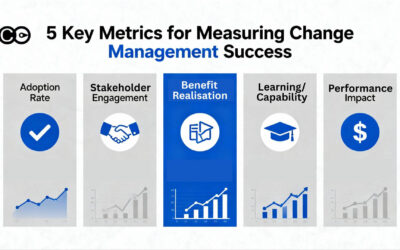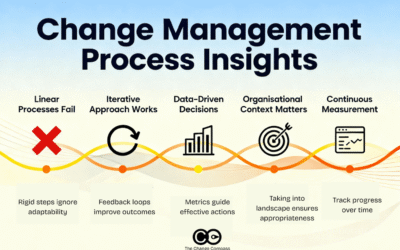Most change practitioners follow a standard change approach. For the past 20 years popular change management content have focused mainly on one part of the discipline – change methodology. As a new-ish discipline there has been a big demand for the ‘how to’ in change management. These include how to follow a sequence of steps in executing a project, and step-by-step path to becoming a better change leader. Clear easy-to-follow steps with associated acronyms have dominated our discipline. A data-driven change approach has not been on the horizon for most organisations.
Is following a methodology bad? Well, not necessarily. A methodology helps to instil critical steps that may ensure that a minimum set of outcomes be achieved in implementing a change initiative. The assumption is that by following these steps, a set of basic work is done that it would be harder to fail. Especially for less experienced change practitioners, following a methodology is highly beneficial.
After while, many also tend to rely on their ‘experience’ and tend to apply similar approaches for most change initiatives. This may be OK if the stakeholders and change initiatives are all similar. However, as stakeholders evolve with changes and new changes take place that are more ‘transformational’ or require different attitudes and skills, then what has worked in the past may not work in the future.
We know that the most popular Google keyword searches in Change Management are mostly related to methodology. For example, some of the most popular keywords include change management process, prosci change management, adkar, etc.
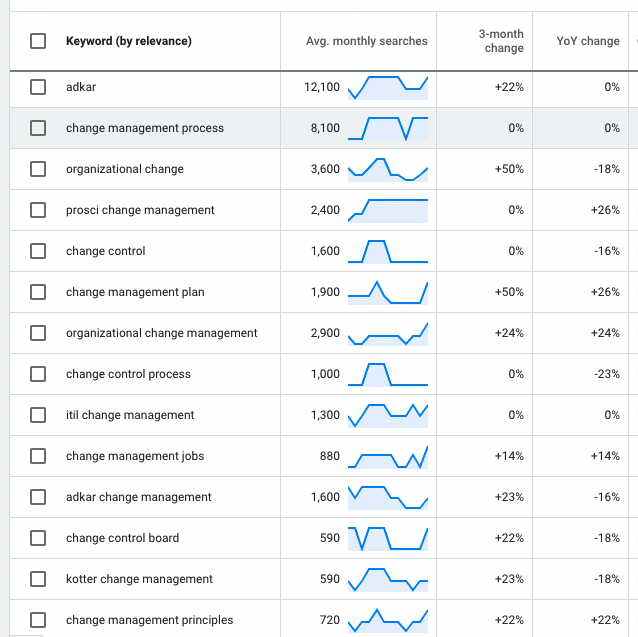
However, the bigger question is should we continue to follow a methodology-driven approach in designing our change approach? In a nutshell, for more experienced change practitioners …. No. For the rest of the article let’s explore why this is the case.
What are the benefits of a data-driven change approach?
- The design of the change approach is supported by data and therefore less biased by personal preferences and unsupported opinions, and as a result when you present the change approach you are less likely to face objections and disagreements
- With the right data, you’re able to articulate the risk of not using a particular change approach
- Ability to take a ‘whole picture’ view of the change landscape in making the right change implementation decisions
- Match the right change approach to the sponsor and executive leadership styles so that the initiative is leveraging those leadership facets, with any supplemented tactics as needed
What is a data-driven change approach?
A data-driven change approach is a change approach that is informed by data. What does this look like?
Business case
With a data driven change approach, historical data of change and business performance informs the business case. Possible data that could be used for business case may include:
- Historical data on business improvement performance results, especially targets vs actual results
- Current operational indicator performance and any previous change and business improvement interventions
- Change maturity of impacted business units including operational maturity in supporting change implementation
Scoping
During initial scoping of the initiative, the following critical data elements may be taken into account:
- Use historical change initiative outcomes to rate potential sizes of impact on business units
- Use easily available data in the areas of people, business operations, and process/systems to assess spread of the impact
Planning
This is traditionally one of the most important parts of change approach design and the phase where all facets of the determined change approach is documented and agreed by stakeholders. Taking a data-driven approach means:
- Using only demonstrable data and evidence to derive an fact-driven change approach
- If there are elements of the change where there has not been previous data available, then early experiments may be designed to test the selected change approach
- Stakeholder engagement approaches are determined based on what has worked in the past, e.g. survey responses from town hall sessions, leader feedback,
- Communications channel and content design are designed based on previous demonstrable methods, e.g. communications hit rate, ‘like’ rate, article viewership, etc.
- Project priority ratings across initiatives to ensure clear alignment for stakeholders
- Portfolio level change impact information from other projects to assist in change release sequencing and capacity planning
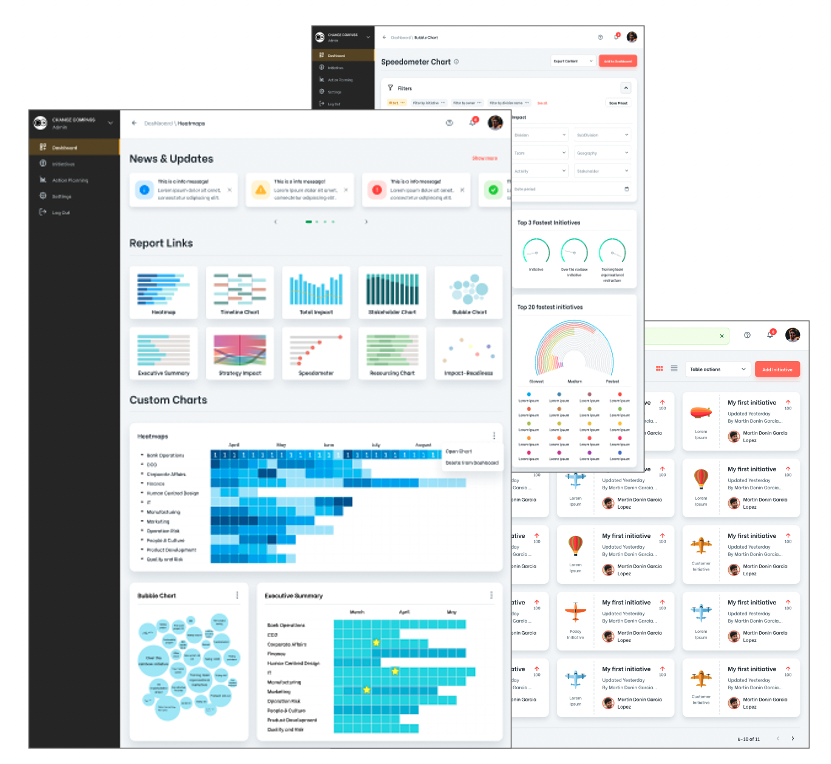
BCG has come up with a simple 2 by 2 grid for determining change strategies. The 2 axes are ‘clarity of ends and ‘clarity of means’. Clarity of ends refers to what the end state looks like, and clarity of means refer to how clear the path is to getting to the end state.
Using this grid there are 5 major different types of change strategies:
- River crossing
- Escaping the swamp
- Souting and wandering
- Planned itinerary
- Hill climbing
It is important to note that whilst this may be a good general reference in determining the change approach, leveraging evidence and data in other aspects of change can greatly determine the right change strategy to be adopted.
In fact if you’re driving a large multi-year transformation, it is likely that you may need to adopt different change approaches during different phases of the program. It also depends how your stakeholders are responding and what approach best suit the situation.
For example, a ‘hill climbing’ approach could be appropriate if it is clear from your stakeholder feedback that upcoming milestones are not super clear. On the other hand, the change is complex and requires persistence and unwielding push from the senior management to continue. Whereas, in the beginning of the transformation journey it maybe that a lot of exploration and discover is required to figure out what the change looks like. In this earlier phase, a ‘escape the swamp’ may be the change approach.
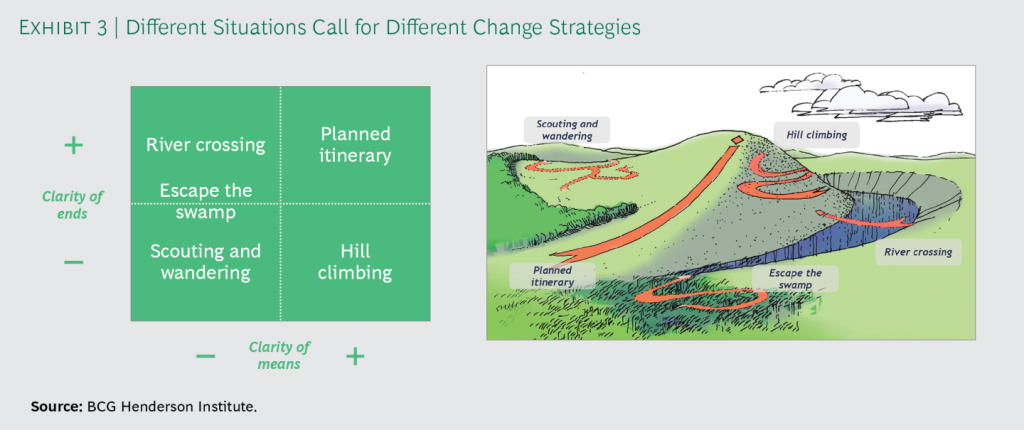
Implementation
This is one of the most critical parts of initiative roll out as this is when the rubber hits the road and change starts to take place. Some of the data-driven aspects of the change approach involves:
- Continuous pulsing and checking of stakeholder readiness
- Regular surveys and dip-stick checks on adoption behaviours and change sentiments from impacted stakeholders
- Monitor business operations performance related indicators that track movements in change adoption
- Social media sentiment analysis of impacted stakeholder groups, and types and amount of questions asked at appointed communication channels, and other potential indicators on people capability in adopting the change
- Training attendance rates, and participant test scores
Ascertaining what the change environment looks like for impacted stakeholders is a key linchpin for a data-driven change approach during the implementation phase. When the ‘rubber hits the road’ as execution starts to take place, you may find that things are not going exactly as planned. It could be that stakeholders completely did not understand the positioning or that change tactics in imparting the value of the initiative did not resonate.
On the other hand, it could be that there is a myriad of other initiatives that the impacted business units are experiencing. Therefore, it is difficult for employees to focus on one set of changes, when there are several types of changes happening concurrently. With lack of focus, coordination and clear priority set by leaders, it often happens that none of the changes land successfully due to saturation and lack of focus.
With the right portfolio level data, it is possible to identify these risks and avoid them altogether. Even if you don’t have easy access to portfolio level change impact data, at least have the conversation with your business stakeholders to understand what else is happening and how are things landing from an employee perspective.
Post release
Even after go-live it is important to keep tracking the change adoption to ensure that there is sufficient continual focus to reach full benefits. In fact this is one of the key reasons why a lot of projects fail. It is because the whole project has been wrapped up too quickly post release and there is not enough accountability and focus placed on continually achieving the benefits targeted.
What are some of the data points to focus on? This depends on the nature of the change. Typical metrics to focus on include:
- System usage rates
- Cost reduction
- Revenue increase
- Transaction speed
- Process efficiency
- Speed of decision making
- Customer satisfaction rate
- Employee productivity rate
- Incidents of process violation
For a comprehensive article on how to measure change visit The Ultimate Guide to Measuring Change.
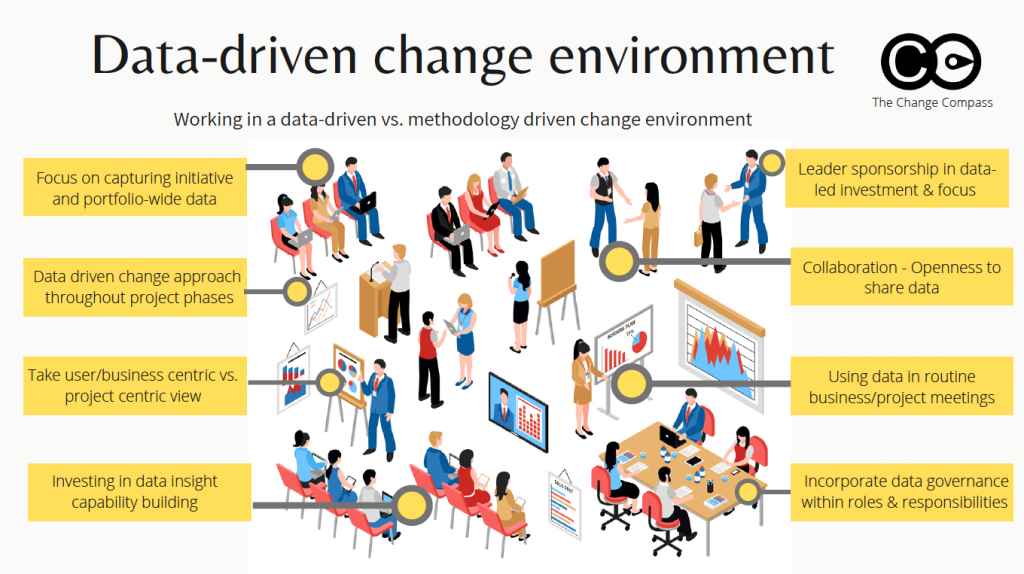
What does a data-driven change environment look like?
In the previous section we focused on all the various data points that can be leveraged throughout a project to make data-driven change decisions to move the initiative forward toward the right trajectory.
In an organisation where data drives how change is designed, orchestrated and implemented … what would this look like?
Let’s approach this in 5 different themes in order to describe core practices that should take place to support an environment that thrives on data-driven change.
1. Democratisation of data/Openness to share data
Data democratisation has been an emerging them in the IT and analytics world. What it means is basically that everyone has access to a range of data and that there aren’t unnecessary gatekeepers that control the data and stopping the data being shared. The data can be used to run the business, understand what is happening, conduct rootcause analysis and overall make better business decisions.
The overall goal is to have as many people as possible access data with little barriers in accessing the data and knowing how to read and understand the data.
Imagine an organisation where employees and managers have access to change data and have the ability to understand what is happening, how each other are responding to change, their concerns and how this is supporting or impeding change. There is significant power in harnessing the greater understanding for the change that is being driven, to garner involvement, engagement and connection.
2. Investing in capturing and publishing data
An assumption in the previous theme is that the organisation has the focus on collecting and harvesting the data. This includes change data. Without the investment in gathering change data there will be nothing to work with.
There is no doubt that most progressive organisations understand the importance of investing in data collection and analysis. There are many ways to determine the value of the data. These include opportunity cost, regulatory fines or settlement value. In terms of the value of change data, the best way to understand it is in terms of opportunity cost, where without the right data there could be significant cost in making the wrong change tactic decisions.
Further more, there is significant benefit in monitizing the company’s historical change data. Some examples of this include the ability to use historical change data to determine seasonal workloads on particular stakeholder groups and roles. Change data may also be linked to other business performance data to track overall change adoption and benefit realisation. Let’s say one project is aiming for $2 million in benefits, and across the project portfolio the total benefits targeted is $15 million. Even if change data supports just 20% of the achievement of full benefits, this equates to $3 million just in terms of tangible financial benefits. There are also non-tangible benefits that can be tracked as well.
3. Incorporating data governance
Data governance is about defining who within the company has control over data assets and how these data assets might be used. This includes people, process, and technology required to manage and protect the data assets.
For IT, Marketing and HR departments the concept of data governance is part of the expected parts of managing the function. There are often dedicated roles, teams and committees in undertaking data governance processes and systems.
For change data, there is also a need to ensure that there is some level of data governance. This does not necessary mean building a complex function if there is no need for such. What it does mean is to have concerted focus and effort to ensure that the change data is managed in a way to ensure that the data is achieving the value that the organisation is looking for.
Some elements of data governance here may include:
Data storage and operations: Ensuring that the data is stored in a safe, and easily accessible location
Data security: Ensuring that the right privacy and access level is provided, however without so much control that user access is inhibited
Data integration and interoperability: The change data should be easily extracted, shared, replicated and utilised across systems if required
Documents and content: There are different types of change data, and the trick is to ensure all these different types of files and data are easily accessible
Data quality: Ensuring that the data is updated sufficiently and can be trusted is key. “Rubbish in, rubbish out” is a common phrase that is true nonetheless. Data that is not constantly refreshed is also one that will not deliver value to the organisation.
4. Leadership support
Like everything with managing change, leadership support is critical. Some go as far as saying that without leadership support no change will fly. This may not be true since there are lots of examples of grassroots-driven changes that are not initially driven by leaders. The same goes with driving a data-driven change environment.
Getting the blessings from your senior leaders will go a long way to driving a ‘data is king’ change environment. However, even if your leaders do not start out being your champions, there are ways to nourish and develop their support.
In business, leaders naturally look to data to make various decisions. Traditionally in change management tangible and visual data has not always been plentiful to support decision making. As a result, leaders may not know how to read, interpret and utilise change data. You will need to educate and support leaders to understand how to utilise change data and guide them through examples and scenarios.
5. Collaboration across initiatives
Teams are effective for various reasons. When you’re in a team you are able to form strong personal relationships and receive that support that you need. Through ongoing work with your team you can focus on a set of outcomes that you can contribute together with the team.
However, the nature of teams is that you will by design see other teams as ‘outsiders’ and have less intimate relationship with them. Those you are less familiar with you also develop less trust.
And as a result, project teams tend to stick within their own teams and focus on working with their particular set of stakeholders. However, to design a better employee or customer experience in planning for change, initiatives need to work together. There will be plenty of situations where changes in releases, planned activities will be better shifted to achieve a better employee outcome.
In situations where there is multiple releases impacting the same stakeholder group, most will leave it to the project management office to make the priority call. However, the process of escalating the issue for decisions to be made takes time and may sometimes create unnecessary anxiety across concerned project teams. A better way to approach this with the right change data is that project teams can proactively work together as a part of release and stakeholder readiness planning.
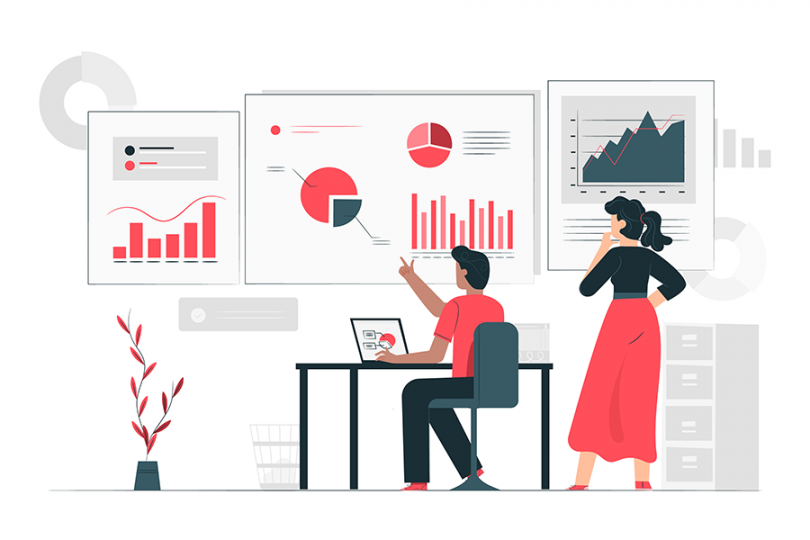
What is the overall opportunity in taking a data-driven vs. methodology driven change approach? Hopefully this article has convinced you some of the advantages and how to go about applying it. “Data is the new oil for the digital economy”. With Covid the reliance of business on data has been a wakeup call. This will continue to intensity in the years to come. For change practitioners we also need to adopt a data-centric approach in our work with the organisation. The alternative could be that we lose our influence, trust and relevance for the business in this digital world where data is embedded within all facets of our lives.
What will your next step be in taking a more data-driven change approach?
To learn more about building change analytics capability click here.





